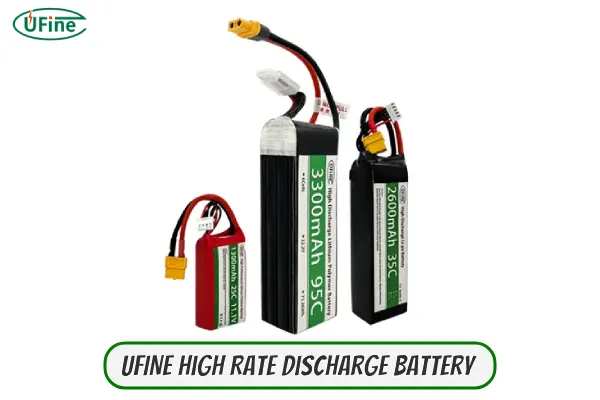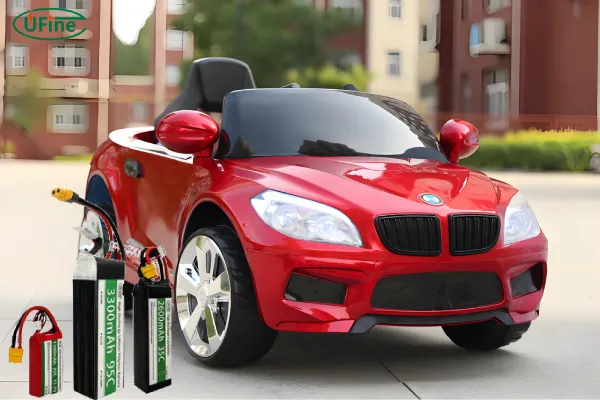The heart of any RC car is its battery. It’s the energy source that propels your vehicle, enabling exhilarating speeds, impressive stunts, and extended playtime. With a myriad of options available, selecting the right RC car battery can be daunting. This guide aims to demystify the process, helping you choose the ideal battery to optimize your RC car’s performance and longevity.
Part 1. Types of RC car batteries
Several battery types have been used in RC cars over the years, each with its own set of advantages and drawbacks.
-
Nickel-Cadmium (NiCd) Batteries: Once the dominant force in the RC car market, NiCd batteries have largely been replaced by newer technologies due to their inherent drawbacks. They suffer from the “memory effect,” where repeated partial discharges reduce battery capacity, and they also exhibit a high self-discharge rate. Additionally, their environmental impact has led to their decline in popularity.
-
Nickel-Metal Hydride (NiMH) Batteries: As a successor to NiCd batteries, NiMH batteries offered improvements in terms of energy density and reduced memory effect. However, they still fell short of the performance standards set by LiPo batteries.
-
Lithium-Polymer (LiPo) Batteries: The current gold standard for RC car enthusiasts, LiPo batteries excel in terms of power-to-weight ratio, energy density, and overall performance. They offer higher discharge rates, longer runtimes, and quicker charging times compared to their predecessors. While they require specific chargers and careful handling, their advantages far outweigh the drawbacks.
Due to their superior performance and efficiency, LiPo batteries have become the preferred choice for most RC car enthusiasts.
Part 2. Common voltages for RC car batteries
The voltage of an RC car battery is a crucial factor determining its power output and suitability for different vehicle types. Common voltages include:
-
7.4 Volts: Suitable for smaller, less powerful RC cars, offering a balance of runtime and speed.
-
11.1 Volts: A popular choice for a wide range of RC cars, providing a good combination of power and runtime.
-
14.8 Volts: Designed for high-performance models, delivering increased speed and power but often at the expense of shorter runtime.
Ufine Battery is a famous Chinese custom lithium battery manufacturer. We can customize batteries of different sizes, shapes, voltages and capacities for your RC cars. Contact us now to customize batteries!
Part 3. The impact of battery capacity on RC car performance

Battery capacity, measured in milliampere-hours (mAh), determines the battery’s energy storage capacity. A higher mAh rating indicates a larger battery with a longer potential runtime.
A battery with a higher capacity can:
-
Extend playtime between charges, allowing for longer driving sessions.
-
Provide more consistent power output, preventing voltage sag, which can affect performance.
-
Handle higher current demands, especially in demanding conditions like off-roading or racing.
However, it’s important to balance capacity with weight and size considerations. A larger battery can impact the vehicle’s handling and performance.
Part 4. What capacity battery should my RC car use?
Selecting the optimal battery capacity involves considering several factors:
-
Vehicle type and size: Larger, more powerful vehicles typically require higher capacity batteries.
-
Driving style: Aggressive driving styles that demand sustained high power output benefit from higher capacity batteries.
-
Terrain: Off-road conditions often necessitate higher capacity batteries to handle the increased power demands.
-
Desired runtime: Determine how long you want to drive between charges and select a battery capacity accordingly.
It’s essential to find a balance between capacity and weight. A larger battery might provide longer runtime but can negatively impact the vehicle’s handling and performance.
High C-Rating RC Batteries: Power or Peril?
Part 5. How to choose RC Car battery connectors?
1. Types of RC Car battery connectors
RC car battery connectors serve as the crucial link between your battery and the car’s electronic speed controller (ESC). They allow for efficient power transfer and easy battery swapping. Here are some of the most common types:
Deans/T-Plug:
- Characteristics: A classic choice, known for its T-shaped design. Offers good current handling and a secure connection.
- Pros: Durable, widely available, and relatively affordable.
- Cons: Can be a bit difficult to solder, and counterfeits are common.
XT60:
- Characteristics: Popular for its balance of size, current capacity, and ease of use. Features a simple, keyed design to prevent reverse polarity.
- Pros: Easy to solder, handles high currents well, and offers a secure connection.
- Cons: May not be ideal for extremely high-power setups.
XT90:
- Characteristics: Designed for higher current applications than XT60. Larger and more robust.
- Pros: Excellent for high-power setups, handles large currents efficiently.
- Cons: Can be bulkier, may not be necessary for all RC cars.
EC3/EC5:
- Characteristics: Another popular option, known for its “bullet” style connectors that provide a large contact area. EC3 is for lower current, EC5 for higher.
- Pros: Good current handling, reliable connection.
- Cons: Can be slightly more challenging to solder than XT60.
Traxxas:
- Characteristics: Used exclusively on Traxxas vehicles. Features a unique design with small pins.
- Pros: Secure connection, designed for Traxxas vehicles.
- Cons: Only compatible with Traxxas, soldering can be tricky.
Tamiya:
- Characteristics: Once common, now less popular due to lower current capacity.
- Pros: Simple and inexpensive.
- Cons: Not suitable for high-power setups, can overheat and melt.
2. Choosing the Right Connector
Here’s a guide to help you select the best connector for your RC car:
Consider your car’s power requirements:
- Lower power (e.g., brushed motors, smaller scale cars): XT60, Deans, or EC3 might be sufficient.
- Higher power (e.g., brushless motors, larger scale cars): XT90, EC5, or high-quality Deans are recommended.
Think about ease of use:
- Ease of soldering: XT60 is generally considered the easiest to solder.
- Ease of connection/disconnection: All the listed connectors are relatively easy to use, but some may prefer the keyed design of XT60.
Compatibility:
- Battery and ESC: Ensure the connector you choose is compatible with both your battery and ESC. If they have different connectors, you may need an adapter.
- Existing equipment: If you have multiple RC cars, it might be convenient to use the same connector type across all of them.
Quality:
Genuine connectors: Always opt for genuine connectors from reputable brands to ensure quality and safety. Counterfeit connectors can have poor conductivity and may even be a fire hazard.
3. Key Considerations
- Soldering skills: If you’re not comfortable with soldering, consider having a hobby shop or experienced friend do it for you. Proper soldering is crucial for a reliable connection.
- Safety: Always prioritize safety when working with RC batteries and connectors. Double-check polarity before connecting, and use heat shrink tubing to insulate connections.
- Future-proofing: If you plan to upgrade your RC car in the future, consider choosing a connector that can handle higher power levels to avoid having to switch later.
Part 6. How to choose a suitable RC car battery charger?
A compatible and efficient charger is essential for maintaining battery health and maximizing its lifespan. Key factors to consider when selecting an RC car battery charger include:
-
Compatibility: Ensure the charger is compatible with your battery type (LiPo, NiMH, NiCd) and voltage.
-
Charging rate: The charger’s output current determines charging speed. Balance charging speed with battery health.
-
Safety features: Look for chargers with overcharge, over-discharge, and short-circuit protection.
-
Balance charging: For LiPo batteries, a balance charger is essential to maintain cell equilibrium.
-
Additional features: Some chargers offer features like storage mode, discharge function, and temperature monitoring.
Invest in a quality charger from a reputable brand to protect your battery investment.
Part 7. How long does an RC car battery last?
The lifespan of an RC car battery depends on several factors:
-
Battery type: LiPo batteries generally have longer lifespans compared to NiMH and NiCd.
-
Charging and discharging cycles: Proper charging practices and avoiding deep discharges extend battery life.
-
Storage conditions: Storing batteries in a cool, dry place at a partially charged state (around 30-50%) helps preserve their lifespan.
-
Usage patterns: Frequent high-discharge cycles can accelerate battery degradation.
By following proper care and maintenance, you can extend the life of your RC car battery.
Part 8. How to charge an RC car battery
Charging an RC car battery requires careful attention to ensure safety and optimal performance. Follow these general guidelines:
-
Use the appropriate charger: Match the charger to your battery type and voltage.
-
Follow the charging instructions: Refer to the charger’s manual for specific guidelines.
-
Monitor the charging process: Avoid unattended charging and disconnect the battery once fully charged.
-
Store batteries properly: Store batteries in a cool, dry place at a partially charged state.
Proper charging habits contribute significantly to the battery’s overall lifespan and performance.
By understanding the intricacies of RC car batteries and following these guidelines, you can optimize your vehicle’s performance, extend battery life, and enhance your overall RC car experience.
Related Tags:
More Articles

How to Choose the Best Floor Scrubber Battery for Commercial Cleaning?
Selecting the ideal floor scrubber battery ensures a long runtime, rapid charging, and minimal maintenance for efficient commercial cleaning operations.
Battery for Blower vs Battery for Leaf Vacuum: Which One Should You Choose?
Battery for blower vs leaf vacuum—learn the key differences in power, fit, and runtime to choose the right battery for your outdoor tool needs.
How to Choose the Right Battery for Blower?
Choosing the right blower battery? Consider voltage, capacity, chemistry & usage. This guide helps match the best battery for peak performance.
How to Choose the Best Insulated Battery Box for Lithium Batteries?
Choosing the Best Insulated Battery Box for Lithium Batteries? Discover key factors such as size, material, and safety for optimal protection and performance.
7 Critical Elements on a Lithium Battery Shipping Label
What must be on a lithium battery shipping label? Learn 7 key elements to ensure safety, legal compliance, and correct handling across all transport modes.






